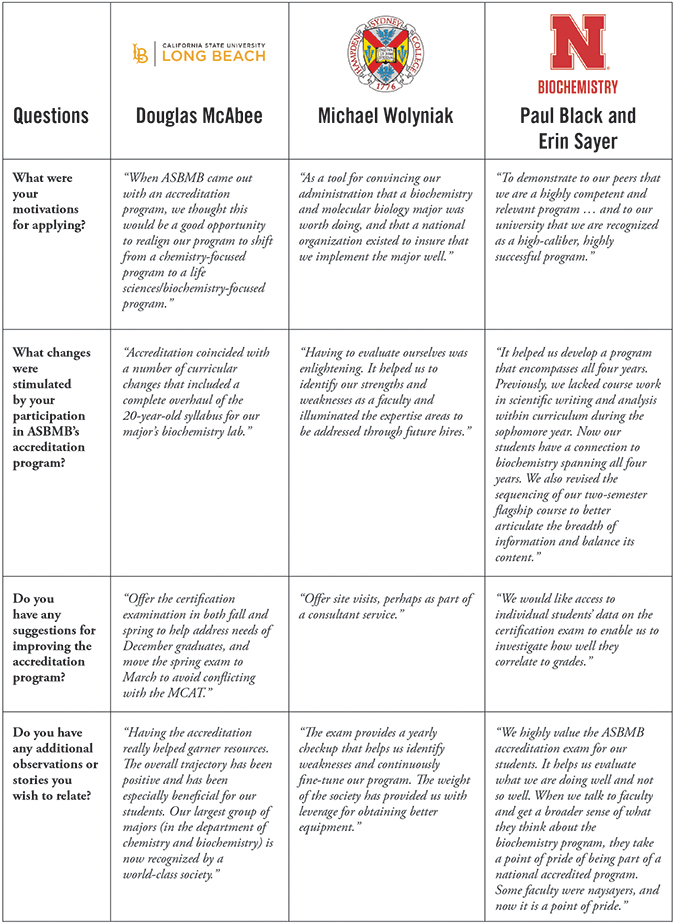Accreditation: Participant perspectives, in triplicate
The number of baccalaureate programs accredited by the ɬ� has grown steadily. By the end of 2019, just six years after the accreditation program began, the number of accredited programs likely will reach the century mark.
Despite the program’s progress, many potential participants still ask, “Why should our program become accredited?”
 Jason Pough, Tony Rivas, and Khoa Tran, all undergraduates at Hampden-Sydney College in Virginia, work on a summer project designed around the proteomic analysis of mucus from local fish species.Hampden-Sydney College
Jason Pough, Tony Rivas, and Khoa Tran, all undergraduates at Hampden-Sydney College in Virginia, work on a summer project designed around the proteomic analysis of mucus from local fish species.Hampden-Sydney College
We have addressed this question in three ways. The first was via of accreditation stakeholders recently published in the journal Biochemistry & Molecular Biology Education. The second was the recent publication of describing details of the program in the journal CBE-Life Sciences Education. The third was by reaching out to representatives of three diverse accredited programs to learn how ASBMB accreditation has affected their programs:
Douglas McAbee of California State University Long Beach, a large (enrollment 37,000), public, master’s granting institution on the West Coast;
Michael Wolyniak of Hampden-Sydney College, a small (enrollment 1,100), private, primarily undergraduate institution in the mid-Atlantic region; and
Paul Black and Erin Sayer of the University of Nebraska, a large (enrollment 25,000), public, research-intensive university in the Midwest.
Overall, these programs reported the following benefits of accreditation:
| • | the focus on concept-based education in the accreditation application helps them critique and improve their programs; |
| • | guidelines from a national society help them strengthen the programs at their institution; and |
| • | accreditation of the program and certification of students through a common exam help create assessments for internal and external use. |
On the facing page, in chart form, are their more detailed answers to our questions.
Want to learn more about the ASBMB accreditation program? Go to the .

Enjoy reading ASBMB Today?
Become a member to receive the print edition four times a year and the digital edition monthly.
Learn moreFeatured jobs
from the
Get the latest from ASBMB Today
Enter your email address, and we’ll send you a weekly email with recent articles, interviews and more.
Latest in Careers
Careers highlights or most popular articles

Sketching, scribbling and scicomm
Graduate student Ari Paiz describes how her love of science and art blend to make her an effective science communicator.

Embrace your neurodivergence and flourish in college
This guide offers practical advice on setting yourself up for success — learn how to leverage campus resources, work with professors and embrace your strengths.

Upcoming opportunities
Apply for the ASBMB Interactive Mentoring Activities for Grantsmanship Enhancement grant writing workshop by April 15.

Quieting the static: Building inclusive STEM classrooms
Christin Monroe, an assistant professor of chemistry at Landmark College, offers practical tips to help educators make their classrooms more accessible to neurodivergent scientists.

Unraveling oncogenesis: What makes cancer tick?
Learn about the ASBMB 2025 symposium on oncogenic hubs: chromatin regulatory and transcriptional complexes in cancer.

Exploring lipid metabolism: A journey through time and innovation
Recent lipid metabolism research has unveiled critical insights into lipid–protein interactions, offering potential therapeutic targets for metabolic and neurodegenerative diseases. Check out the latest in lipid science at the ASBMB annual meeting.


